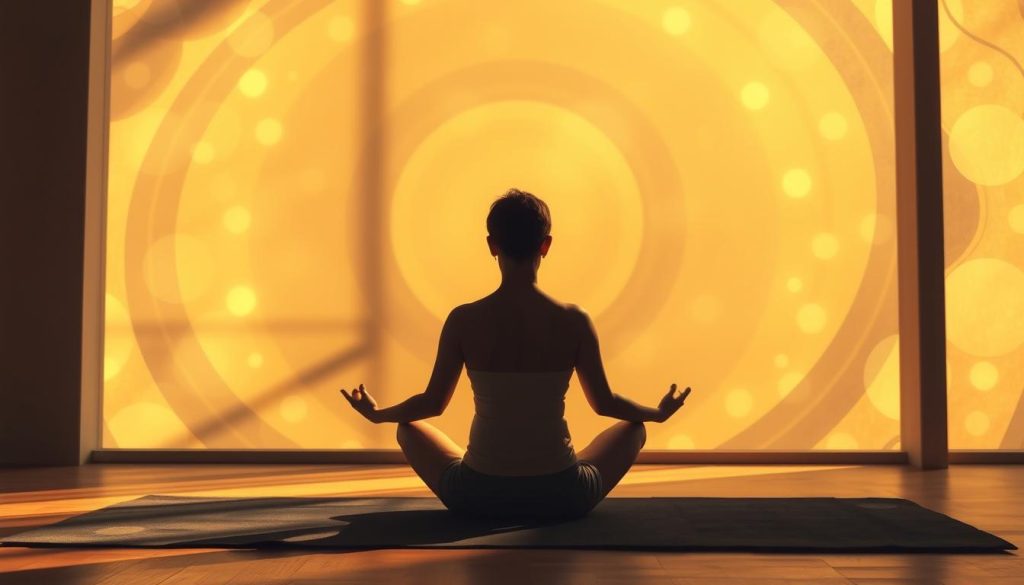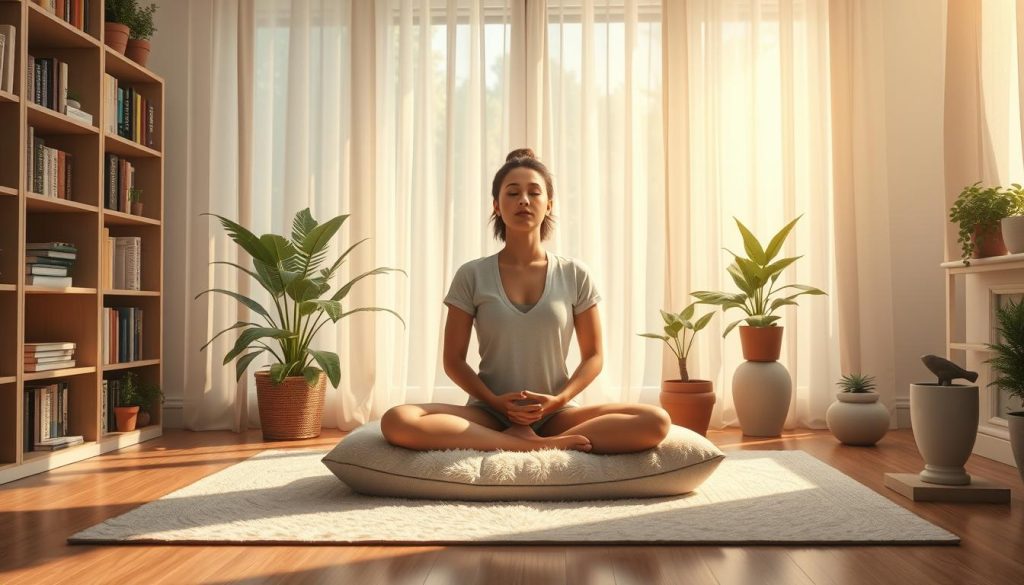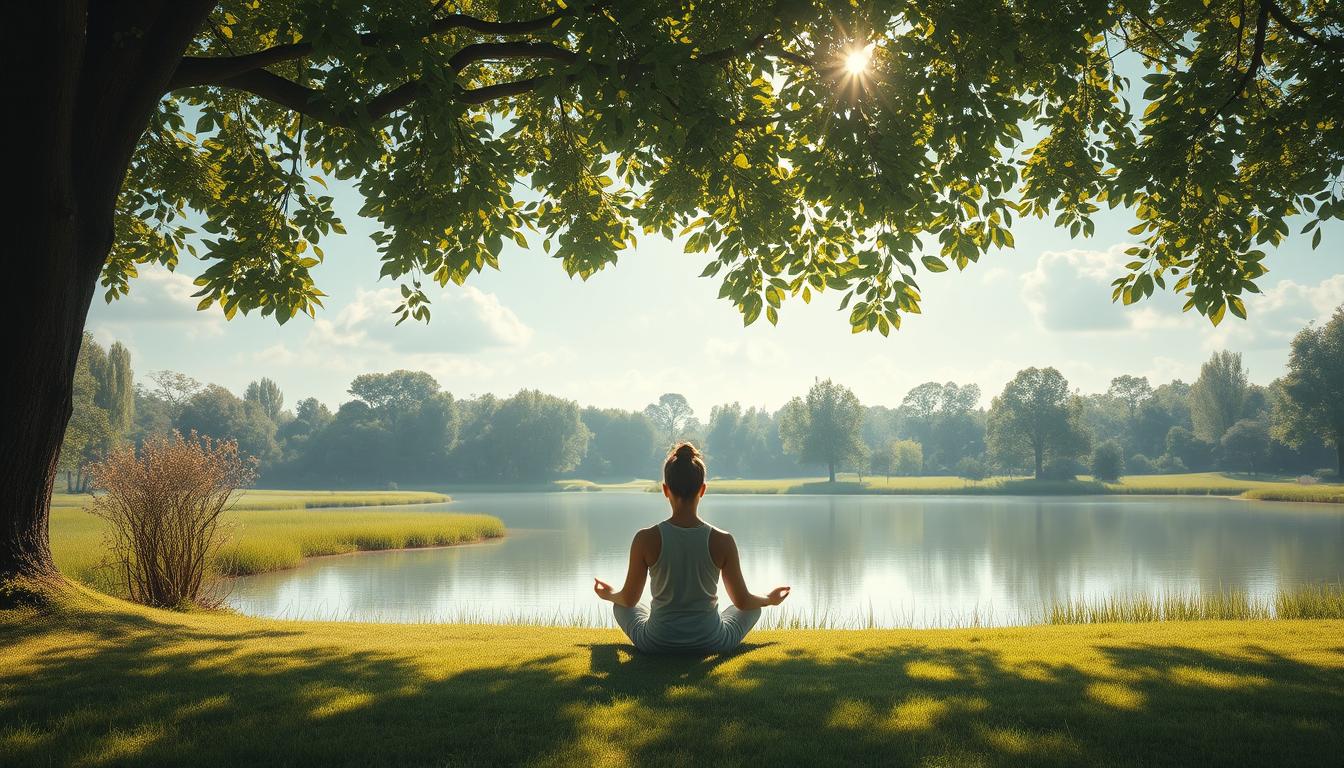Modern life disrupts our sleep patterns. Technology keeps us up late. Work schedules change often. Our bodies struggle to keep natural rhythms in this fast world.
Mindfulness offers a strong solution. Focused breathing and awareness of our internal clock help. Our body starts to sync with its natural cycles again.
Science backs up the link between meditation and our body’s clock. Simple mindfulness techniques help us sleep better and wake up feeling refreshed.
Today, we need tools that fit our busy lives. By combining meditation and circadian balance, we can make lasting changes. You’ll learn how small daily habits can boost your energy and well-being.
Understanding Circadian Rhythms and Their Importance
Your body has a natural timing system that controls your health and well-being. This system has evolved over millions of years. Knowing how it works can help you live better.
But, modern life often messes with our natural rhythms. We stay up late, work odd hours, and are exposed to artificial light. These habits can harm our health in unexpected ways.
What Are Circadian Rhythms?
Circadian rhythms are your body’s 24-hour clock. They tell you when to be alert, sleepy, hungry, and full of energy. The word “circadian” means “about a day” in Latin.
Your master clock is in a small part of your brain called the suprachiasmatic nucleus. It gets light and dark signals from your eyes. Then, it sends signals to control your body’s processes.
Here are the key functions that circadian rhythms control:
- Sleep-wake cycles and alertness levels
- Body temperature fluctuations
- Hormone production and release
- Digestive processes and metabolism
- Blood pressure and heart rate variations
Keeping a regular daily routine helps your body clock stay in sync. Your internal clock expects certain activities at specific times. Eating, sleeping, and waking up at the same times keeps your rhythms balanced.

How Circadian Rhythms Affect Health
When your circadian rhythms work right, they support great health. You sleep better and your immune system works well. Your mood and mental clarity also improve.
But, disrupted rhythms can cause health problems. Night shift workers and travelers often face these issues. The effects go beyond just feeling tired.
Research shows that disrupted rhythms can lead to:
- Sleep disorders and chronic insomnia
- Increased risk of diabetes and obesity
- Weakened immune system function
- Higher rates of depression and anxiety
- Cardiovascular problems and high blood pressure
Your metabolism also depends on your circadian rhythm. Your body processes food better at certain times. Eating late can mess with this and affect your weight.
Mental performance also follows your rhythm. Most people are most alert in the late morning and early evening. Knowing your rhythm can help you plan your day better.
The Role of Light and Sleep in Circadian Balance
Light is key to keeping your rhythms in sync with the world. Your eyes send light signals to your master clock. This helps your body clock stay in sync, even with changing schedules.
Natural sunlight is the strongest cue. Morning light makes you feel awake and ready. As evening comes, your body starts making melatonin, which helps you sleep.
But, artificial light can confuse your brain. Blue light from screens and LEDs can make you think it’s still day. This can make it hard to fall asleep and reduce sleep quality.
Consistent sleep times help your rhythms stay strong. Your body learns to expect these times. Regular sleep improves your overall sleep quality.
Healthy light exposure patterns support better rhythms:
- Get bright light exposure within the first hour of waking
- Spend time outdoors during daylight hours when possible
- Dim lights in your home 2-3 hours before bedtime
- Use blue light filters on devices in the evening
Temperature also helps regulate your rhythms. Your body temperature drops in the evening, signaling sleep time. A cool bedroom can help you sleep better.
The Benefits of Meditation for Well-Being
Meditation is a powerful practice that boosts your well-being. It has been shown to improve both mental and physical health. This ancient practice brings positive changes to your daily life.
It helps your body and sleep patterns. Regular meditation makes you better at handling challenges and staying balanced.
Reducing Stress and Anxiety through Meditation
Meditation is great for managing stress. It lowers cortisol levels, helping you sleep better and stay in rhythm.
It teaches your nervous system to relax. After a few weeks, you’ll feel less stressed and have more energy.
Enhancing Focus and Clarity
Meditation improves your focus and mental clarity. It trains your mind to stay present. This helps with decision-making and solving problems.
You’ll notice better concentration during work or study. You’ll be less distracted and recognize when you need rest. This leads to healthier sleep.
Promoting Emotional Resilience
Meditation makes you more emotionally stable. It helps you handle emotions better. You’ll stay calm even when things get tough.
It teaches you to watch your emotions without getting overwhelmed. This skill keeps you emotionally balanced. It also helps you sleep better by reducing stress and worry.
These benefits create a positive cycle for your health. Less stress and better mental clarity lead to healthier sleep and rhythms.
How Meditation Influences Circadian Balance
Meditation is a powerful tool for keeping your body’s internal clock in sync. It affects key hormones that control when you sleep and wake. Regular meditation helps your body stay in a rhythm that supports better sleep and health.
Meditation affects your body’s internal clock through several ways. It lowers cortisol levels, which can mess with your sleep if too high. It also boosts melatonin, the hormone that tells your body it’s time to sleep.

Aligning Meditation with Your Circadian Cycle
Timing your meditation right can make it more effective for your body’s rhythms. Morning meditation sets a positive tone for the day. It tells your body it’s time to be alert and focused.
Evening meditation has a different role. It helps your nervous system relax, preparing your body for sleep. This is key for quality sleep.
Here are some tips for timing your meditation:
- Morning sessions: 6-8 AM to boost alertness
- Midday practice: 12-2 PM to reset energy levels
- Evening meditation: 7-9 PM to promote relaxation
- Pre-sleep routine: 30 minutes before bedtime
Techniques to Optimize Your Meditation Practice
Different meditation techniques work best at different times. Morning is for energizing practices like focused breathing. Evening is for calming techniques like body scans.
Breathing exercises are great for circadian health. Try the 4-7-8 technique in the evening: inhale for 4 counts, hold for 7, and exhale for 8. This activates your parasympathetic nervous system.
Progressive muscle relaxation is good for releasing tension. Start with your toes and work up, tensing and releasing each muscle group. It signals your body to wind down.
Evidence Supporting Meditation and Sleep Quality
Research shows meditation improves sleep quality and duration. People who meditate regularly fall asleep faster and sleep deeper. They wake up feeling refreshed.
Studies show meditation increases melatonin production by up to 300%. This helps regulate your sleep-wake cycle naturally. Regular practitioners also have more stable cortisol levels throughout the day.
Brain imaging studies show meditation strengthens sleep regulation areas in the brain. It literally rewires your brain for better circadian function. These changes get stronger with consistent practice over time.
Practical Ways to Incorporate Meditation into Daily Life
Modern life needs easy ways to add mindfulness to our daily lives. Meditation doesn’t need long sessions or perfect places to work. You can add calm and awareness to your day, helping your mind and body.
Start small and grow your practice. Even short moments of breathing can change your stress and balance.
Short Meditation Practices for Busy Schedules
Even busy people can meditate. Quick techniques fit into your day without interrupting it.
Try the “3-3-3 breathing technique” during your commute or coffee break. Breathe in for three, hold for three, and out for three. Do this three times. It’s quick but can lower stress and focus your mind.
Walking meditation is great for busy folks. Use your lunch break or while moving to focus on each step and breath. It turns walking into a mindful experience.

Micro-meditations are perfect for daily transitions. Spend 30 seconds on your breath before emails, starting your car, or meetings. These short pauses reset your system and keep you balanced.
Setting a Regular Meditation Routine
Being consistent is key, not how long you meditate. Pick a time that fits your natural rhythm.
Morning meditation is good for many because cortisol is high then. A 5-10 minute session can set a positive day. If mornings are tough, try evening to relax before sleep.
Begin with just five minutes a day at the same time. Use reminders or link it to a daily routine like coffee. This helps make it a habit.
Don’t worry about missing a day. Just start again the next day. Being flexible helps make lasting habits.
Apps and Resources for Guided Meditation
Technology helps with meditation with easy techniques and programs. Apps like Headspace and Calm offer sessions from three to sixty minutes.
Insight Timer has a huge library of free meditations from teachers all over. It also has timers and community features.
For simple practice, timer apps with gentle sounds work well. YouTube has many free guided meditations for sleep, anxiety, or focus.
Find what works for you. Some like detailed guides, others prefer sounds or silence. Try different things to find what you like.
Creating a Harmonious Environment for Meditation
Creating the right environment for meditation can change your practice and help with healthy sleep patterns. Your surroundings affect how well you relax and respond to meditation. A well-designed space tells your mind and body it’s time to slow down and connect with your natural rhythms.
The environment you choose impacts your focus and ability to relax. Whether it’s a dedicated room or a corner of your bedroom, small changes can greatly improve your meditation.
The Best Settings for Meditation
You don’t need a big house or expensive changes to create a good meditation space. What’s most important is being consistent, not perfect.
Indoor spaces are often better because you can control the light and temperature. Find a quiet, peaceful spot. It could be a corner of your bedroom, a part of your living room, or even a walk-in closet.
Natural light is key for your body’s natural rhythms. Place your meditation spot near a window, but avoid direct sunlight. Soft, filtered light helps keep your circadian balance and creates a calm atmosphere.
Outdoor meditation is great when the weather is good. Gardens, patios, or quiet parks offer natural sounds and fresh air. But, have an indoor spot for consistent practice.
Tools and Accessories to Enhance Your Practice
You don’t need to spend a lot to make a good meditation space. Simple, affordable tools can make a big difference in your comfort and focus.

- A comfortable cushion or meditation pillow for proper posture support
- A soft blanket to maintain body temperature during longer sessions
- A timer or meditation app to track your practice without watching the clock
- Essential oils or a diffuser for aromatherapy benefits
- Noise-canceling headphones or earplugs for busy environments
Sound can greatly enhance your meditation. White noise machines, nature sounds, or soft instrumental music can help mask distractions. Many find that consistent background sounds improve their relaxation techniques.
Think about your budget when picking accessories. A folded towel can be as good as an expensive cushion. The goal is to find tools that support your comfort and help you practice regularly.
Adjusting Your Space to Support Circadian Health
Your meditation environment can support your body’s natural rhythms when designed well. The timing and lighting of your space are key for healthy circadian patterns.
Morning meditation benefits from gentle, increasing light that mimics sunrise. Use a dawn simulation lamp or position yourself for natural morning light. This helps signal to your body that it’s time to wake up.
Evening meditation needs different settings. Dim, warm lighting helps prepare your body for sleep. Avoid bright screens or harsh overhead lights for at least an hour before. Candles or salt lamps create a perfect ambiance for evening relaxation.
Temperature control is important for comfort and circadian health. Keep your meditation space slightly cool, around 65-68°F. This naturally supports relaxation and aligns with your body’s evening temperature drop. A light blanket lets you adjust warmth as needed.
Consistency in your meditation environment trains your body’s natural rhythms. Using the same space, lighting, and scents creates powerful cues for relaxation. Your body starts to prepare for meditation as soon as you enter your space.
Remove electronic devices or put them in airplane mode to avoid blue light and distractions. This simple step helps deepen your meditation and supports better circadian balance, especially in the evening.
Combining Meditation with Other Wellness Practices
Creating lasting wellness means using a holistic approach. This approach combines many healthy habits. When you mix meditation with other wellness practices, you build a strong base for managing stress and keeping your body’s clock in sync.
Nutrition and Its Impact on Circadian Balance
Your diet affects your internal clock. Eating at the same times each day helps keep your circadian rhythms steady. Make sure to finish eating at least three hours before bedtime.
Foods high in magnesium and tryptophan can help you sleep better. Pair them with evening meditation for even better results.
Exercise and Meditation – A Powerful Pair
Exercise and meditation are great together for your health. Morning workouts can reset your body’s clock. Gentle yoga or stretching before meditation helps you relax deeper.
Even a short walk after lunch can boost your afternoon meditation. It also helps you sleep better at night.
Mindfulness Practices Beyond Meditation
Mindfulness goes beyond just sitting meditation. You can practice mindful breathing while you’re on the move. Mindful eating and walking in nature are also great ways to stay present.
These simple habits keep you aware all day. Even taking three deep breaths before checking your phone can keep you grounded and in tune with nature.

